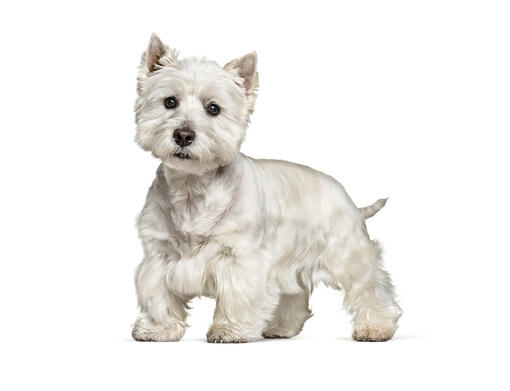
Known for his friendly, strong-willed personality and bright white coat, the West Highland White Terrier is an affectionate, happy and faithful family companion. A highly intelligent, speedy and cunning hunter, the Westie originated in 17th century Scotland. This spunky breed needs daily exercise, and his fluffy coat needs daily brushing and regular trimming.
DID YOU KNOW? The West Highland White Terrier also has been known as the Roseneath Terrier and the Poltalloch Terrier.
ALSO KNOWN AS: Poltalloch Terrier, Roseneath Terrier, White Roseneath Terrier
The need-to-know
- Dog suitable for non-experienced owners
- Some training required
- Enjoys active walks
- Enjoys walking an hour a day
- Small dog
- Some drool
- Requires grooming every other day
- Non hypoallergenic breed
- Chatty and vocal dog
- Guard dog. Barks and alerts
- May require training to live with other pets
- May require training to live with kids
Personality

Courageous, cheeky, jaunty and affectionate, loyal to their families and friends, the Westie is understandably an appealing little dog. Perfectly capable of being trained to a high level with the right encouragement, they still retain that working terrier nature, willing to take on foe many times their size. Not afraid to be confrontational, the Westie is a good watch dog, alerting the whole household loudly to anything they believe constitutes ‘trouble’.
History and Origins

Country of Origin: Scotland
Like many of the Scottish terriers, the Westie was bred to work, hunting otter, fox and other vermin. Unlike any others however they are always white in colour for a unique and tragic reason. Back in the 1600s, Col. Malcolm if Poltalloch was out hunting when he mistook his beloved dark coloured terrier for a fox, shooting and killing him. After that he vowed only to have white dogs to ensure that could never happen again.First called the Poltalloch Terrier, the breed only appeared in the show-ring under the name of West Highland White Terrier in 1904 and has gone on to be one of the best-loved of all the terrier breeds.
Nutrition and Feeding

Small dogs have a fast metabolism, meaning they burn energy at a high rate, although their small stomachs mean that they must eat little and often. Small-breed foods are specifically designed with appropriate levels of key nutrients and smaller kibble sizes to suit smaller mouths. This also encourages chewing and improves digestion.
Exercise

Westies need walks – an hour of exercise per day, but more if you have the time. This is a playful and energetic little dog so providing a variety of walking routes, games, training and puzzle solving exercise is essential.
Other Information

Health and common issues
The most common health problem encountered are skin allergies. The breed can also be affected by an inherited bone disorder of the jaw. Check the Kennel Club website and the breed club for further health information.
Space requirements
Small and compact, the Westie is not difficult to house. A secure garden is essential as they are capable of jumping many times their own height, squeezing through small spaces and digging enthusiastically under an obstacle. Suited to town or countryside, but training will be needed to teach a Westie not to alert bark to every noise or moving object.
Training west highland white terrier
The Westie will enjoy training as long as you set them up to believe it was all their own idea. They will work hard for food rewards and toys they can chase, tug and rag about. Early work on recall, and socialisation to children, cats and livestock is important. An intelligent and versatile dog, if you enjoy training there is no reason the Westie cannot compete well in a variety of dog sports and competitions.
Best family dog breeds
A great companion for older children who can respect a dog’s need for space and take part in training and exercise. Small breeds are not ideal for very young children who find it very difficult to differentiate between ‘toy’ and ‘real live animal’ and terriers are unlikely to suffer such treatment without reaction. While many dogs are traditionally thought of as being good with children, all dogs and children need to be taught to get on with and respect each other, and be safe together. Even so, dogs and young children should never be left alone together and adults should supervise all interactions between them.
Did you know?
- With their bright white coat and dark eyes and nose, the Westie been a long-standing favourite of artists and advertisers for many years. From Gallant the Westie who featured in artist Marjorie Turner’s works in the early 1900’s, to the Black &; White Scotch whisky brand, Rheingold beer and as the face of several dog food brands, the Westies attractive face is undeniably appealing. They also appeal to celebrities and even royals with owners having included HRH The Duchess of Cambridge, Matthew Mc
- Conaughey, Whoopi Goldberg Hugh Laurie and many others.
- Despite their small size they have an incredibly loud bark. Interestingly, they were actually bred this way so that if they ever got stuck underground when hunting, their owner could locate them. West Highland Terriers have very sensitive skin on their ears and they can get sunburnt – so make sure you pop on some dog-safe sunscreen! Westie’s were developed to have a super strong tail that they can be pulled out by if they ever get stuck in a hole.